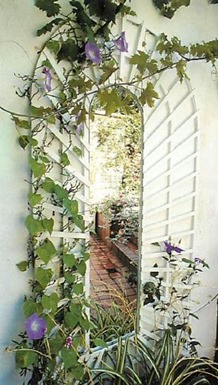





Punctuation or Features
In a trouble-free, low maintenance garden that does not rely on vast displays of carpet bedding, grand herbaceous borders, imposing vistas or specimen plants, well-chosen garden ornaments can enhance a garden in the same way as interesting foliage can. So special features such as a large mirror against a wall framed by an arch of roses, a jardiniere filled with spring-flowering bulbs and trailing plants, a fountain or sundial, will punctuate a garden, create interest and make the fact that the majority of plants are evergreen shrubs less important.
 ‘Punctuation’ or garden features can range from stone ornaments to ornamental trees. Groups of tubs or terracotta pots, sundials, sculpture, fountains, stone lions, dogs, cats, hedgehogs or baskets, bird baths, statues, groupings of large stones, farm implements (such as old cart wheels), garden gnomes, a painted wooden wheelbarrow filled with flowers, and a strategically placed standard weeping rose tree are all excellent features to punctuate the garden.
‘Punctuation’ or garden features can range from stone ornaments to ornamental trees. Groups of tubs or terracotta pots, sundials, sculpture, fountains, stone lions, dogs, cats, hedgehogs or baskets, bird baths, statues, groupings of large stones, farm implements (such as old cart wheels), garden gnomes, a painted wooden wheelbarrow filled with flowers, and a strategically placed standard weeping rose tree are all excellent features to punctuate the garden.
Garden ornaments and statues do not necessarily need to be of exceptional beauty or of great value. Just right for their setting. Years ago I bought a pair of genuine Queen Anne stone baskets of fruit for the terrace. It was sad to discover having bought them that no matter where they were placed they have never looked as remarkable as I had anticipated. The only remark that has ever been made on them is, ‘Oh, you’ve got those nice reconstituted stone reproductions.’ I’m glad they didn’t see the bill!! So much for buying things at an exorbitant price!

So broken statues or pots, fibre glass or plaster animals, or busts made by teenagers at school can all look intriguing if given the right background and a single spotlight at night. Even discarded props from a play look interesting (while they last), especially with ivy growing over them.
Finding the correct sized object for the space is an art in itself. The smaller the garden, the more careful you need to be in your choice.
If, for the sake of economy, you buy plastic containers, avoid using them too near the house and make sure ivy is planted to hang over the side to camouflage the plastic material. Natural textures are more in keeping in the garden and tend to look better than man-made ones. But there are places where you can economise. At the end of the garden you can always get away with less expensive tubs or ornaments, especially if they are under overhanging trees which will help weather them.
Larger features such as wells or fountains are interesting in small gardens as well as in large. Their impressive size gives importance to the space and they lend a romantic rustic quality, as do stone corn ‘stoops’ or mushrooms, stone troughs and benches.
In a large garden, should the well not be a genuine one for drawing water, it can be placed where it is of most ornamental use, away from the house to draw one’s eye into the distance like this simple 16th-century Venetian well. But a functional cottage well needs to be near the house so that the water can easily be drawn if there is a drought. Both wells make attractive features and even the well that is only ornamental could look quite spectacular filled with flowers or placed in the middle of a courtyard or small paved area in a pint-sized garden.
Copyright © www.100flowers.win Botanic Garden All Rights Reserved